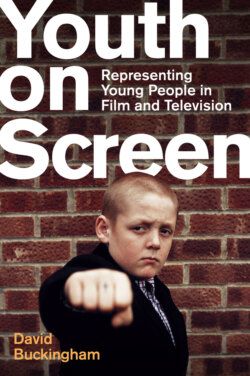Читать книгу Youth on Screen - David Buckingham - Страница 13
Delinquency and the movies
ОглавлениеThe psychologist Frederic Wertham’s enormously influential book The Seduction of the Innocent, published in 1954, drew attention to the effects of comic books, and especially so-called horror comics, on young people’s behaviour. It led to public campaigns in which children were encouraged to incinerate their comic book collections, as well as to new regulatory codes within the industry.7 Meanwhile, the ambitious senator Estes Kefauver initiated and led a Senate Subcommittee to Investigate Juvenile Delinquency, whose hearings lasted for several years between 1953 and the end of the decade (although it continued for many years thereafter). Here, again, comic books came under scrutiny, but the movies were an increasing focus of concern.
The movie industry responded in several ways. Its formal submissions to Kefauver’s Senate investigations were keen to play down the influence of movies – and, in this respect, it was supported by many academics, as well as professional experts such as social workers. Like many participants in these debates, Kefauver was wary of the charge of censorship during a period in which the power of Joseph McCarthy’s House Un-American Activities Committee was starting to wane.
However, the industry was quite ready to censor itself, or at least to strengthen its regulatory codes. All the Hollywood films I consider below – as well as a great many others – were subject to detailed scrutiny by the industry’s Production Code Administration. For example, the original script for The Wild One was rejected on the grounds that it might encourage gang violence: the producers reduced the explicit violence and strengthened the pro-social message by playing up the redemption of the central character.8 Likewise, the script of Blackboard Jungle was adapted to reduce elements of sex, violence and profanity, although this did not enable it to escape criticism (and bans in some cities) once it was released. Other strategies of this kind included extensive ‘health warnings’ in the opening titles, although these were rarely as elaborate as those in Altman’s The Delinquents. In other instances, the ‘voices of authority’ within the film – such as the sheriff in The Wild One – were strengthened and moral ambiguity or complexity was eliminated. Even so, critics within and beyond the industry were not altogether convinced of the effectiveness of such strategies: concerns continued to be expressed about the dangers of young viewers ‘identifying’ with the delinquent characters, however painful their ultimate come-uppance or however convincing their ultimate redemption might have appeared.
At the same time, the industry faced a more fundamental dilemma. Before the 1950s, the cinema had been a genuine mass medium: movie-going was typically an intergenerational experience, with whole families attending together. As the decade progressed, this began to unravel. The advent of television was part of the explanation, obviously; but there were also changes in film production and exhibition (the break-up of the studio system and legislation that made it impossible for studios to retain control of local cinema distribution). The industry gradually came to realize that it was targeting an older audience that was no longer going to the movies very much; and it began, albeit belatedly and uncertainly, to focus on the increasingly lucrative and available audience of teenagers and younger adults.
By the late 1950s, Time magazine was estimating that US teenagers had a combined spending power of $10 billion, of which 16 per cent was spent on ‘entertainment’. This duly led to what the film scholar Thomas Doherty calls the ‘juvenilization’ of American movies: the targeting of young people via movies and stars designed specifically to appeal to them. It also led to changes in film exhibition: teenagers were keen on drive-in movies and on double-bills where they could spend a longer time socializing (or necking).9 The JD movies were one consequence of this – even if elements of them still appear to be targeted towards an older adult audience. Selling representations of juvenile delinquency as a form of entertainment might well have offered a vicarious (and perhaps quite superficial) sensation of power for younger viewers, who experienced relatively little power in their own everyday lives.
This situation posed a dilemma for the industry. On the one hand, it was keen to target the teen audience, not least by promising apparently salacious content; yet, on the other, it needed to convince adult authority figures of its own moral legitimacy. Anxieties about juvenile delinquency made for good box office, but they also increased the visibility of those who criticized the industry for its irresponsibility. Placing overt moral messages alongside sensational portrayals of deviancy was thus a risky strategy, but an economically profitable one.
As we shall see, much of this debate (and of course the movies themselves) spread across to the UK. The industry’s dilemmas here were also quite similar, although they arguably took longer to become apparent. Britain experienced its own home-grown moral panic about the effects of comic books,10 although there was rather less concern about the harmful influence of the cinema. Nevertheless, the release of Blackboard Jungle in 1956 was apparently greeted with ‘riots’ in some UK cinemas, and (astonishingly) The Wild One was banned by the British Board of Film Censors until 1967. Meanwhile, the affluent teenager took a little longer to appear on this side of the Atlantic, becoming apparent to researchers and social commentators only towards the end of the 1950s. Perhaps for some of these reasons, the British film industry’s response to the ‘problem’ of juvenile delinquency was generally rather more restrained, and perhaps even sedate, although it was by no means less contradictory.
